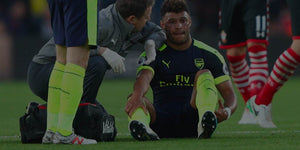How to identify, treat and prevent hamstring muscle injuries
What is a hamstring injury?
A hamstring injury is a strain of one of the three hamstrings muscles at the back of the thigh; usually the biceps femoris muscle. More severe tears of the central hamstring tendon can occur.

When can a hamstring injury occur?
Hamstring injuries are common in soccer, Australian football, rugby, cricket, athletics and other sports that require running with sudden acceleration.
For football codes, hamstring injuries often occur towards the end of a match, when players are becoming tired. Athletes who tend to sustain hamstring injuries are those who have had a previous hamstring injury, have poor core stability, have low back pain, have stiff ankle due to a past ankle sprain, have weak hamstring muscle strength (especially ‘eccentric’ strength), and have tight quadricep and hip flexor muscles (at the front of the thigh and hip). The chance of sustaining a hamstring injury increases with age.
How to identify a hamstring muscle injury
When a hamstring injury occurs, there is a sharp pain in the back of the thigh during a sudden acceleration or kicking on the run.
The pain often prevents the player from playing on. There is pain when the area is touched, muscle weakness and pain if the muscle is stretched. Depending on the severity of the injury, bruising can develop in the days after the injury at the back of the thigh extending to the knee.
How to prevent a hamstring muscle injury and prevent a hamstring injury from recurring
- Fully rehabilitate any previous hamstring injury, ensuring the strength is the same as the uninjured hamstring
- Strengthen hamstring muscles, focusing on eccentric strength with exercises like Nordic dips, single leg hamstring bridges (with foot up on a bench) and straight leg deadlifts
- Improve core stability with exercises like Pilates
- Treat any low back pain
- Fully rehabilitate previous ankle injuries and ensure the knee-to-wall test is equal on both ankles. To check the knee-to-wall test, put a ruler or tape measure on the floor perpendicular to a wall. Face the wall and put the big toe and heel on the tape measure. Position the foot so that when the knee is bent to touch the wall, the heel remains on the ground. Measure the distance from the big toe to the wall. Do the same for the other foot. The measurements should be similar, within 1-2cm. If the difference is more than 2cm, see a healthcare professional like a physiotherapist, osteopath or chiropractor to improve the flexibility of the ankle joint.
- Stretch the quadriceps and hip flexor muscles
- Train for the sport and ensure an adequate fitness level
How to treat a hamstring muscle injury

- For the first 1-2 days, RICE – rest, ice for 20 minutes every 1-2 hours, compress with a bandage or Tubigrip®, and elevate. If severe, use crutches for the first 1-2 days. Expect to take 4-6 weeks to recover.
- Once the initial pain and inflammation has settled, see a healthcare professional to help with rehabilitation, as the risk of re-injuring a hamstring muscle is high.
-
Wear supportive compression - The CORETECH™ range of Supacore's medical grade compression has been engineered to help support the core and keep the pelvis stable during activity.This additional core support provided by CORETECH™ can help the recovery process to take place.
 |



